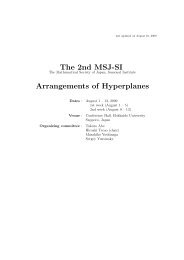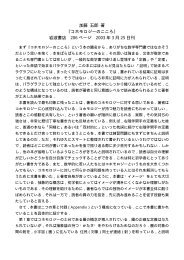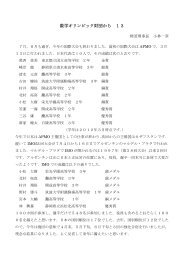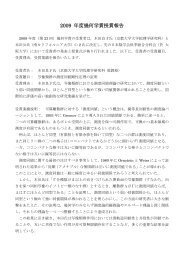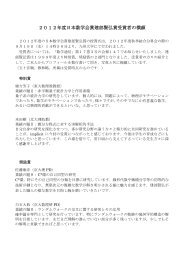Titles and Short Summaries of the Talks
Titles and Short Summaries of the Talks
Titles and Short Summaries of the Talks
Create successful ePaper yourself
Turn your PDF publications into a flip-book with our unique Google optimized e-Paper software.
43 Functional Equations<br />
Final: 2013/2/7<br />
26 Yusuke Kotera (Osaka Univ.) ♯ Hadamard variational formula for general domain perturbation · · · · · · 10<br />
Takashi Suzuki (Osaka Univ.)<br />
Takuya Tsuchiya (Ehime Univ.)<br />
Summary: We study <strong>the</strong> Hadamard variational formula for general domain perturbation, especially<br />
second variational formula for Dirichlet problem <strong>and</strong> mixed problem.<br />
27 Yoichi Miyazaki (Nihon Univ.) ♯ Lp regularity <strong>the</strong>orem for elliptic equations <strong>and</strong> smoothness <strong>of</strong> <strong>the</strong><br />
domain · · · · · · · · · · · · · · · · · · · · · · · · · · · · · · · · · · · · · · · · · · · · · · · · · · · · · · · 12<br />
Summary: We derive <strong>the</strong> Lp regularity <strong>the</strong>orem for elliptic equations under restricted smoothness<br />
assumptions on <strong>the</strong> boundary <strong>of</strong> <strong>the</strong> domain. If <strong>the</strong> elliptic operator is <strong>of</strong> order 2m, we can lessen <strong>the</strong><br />
smoothness assumption by m − 1 in both cases <strong>of</strong> non-divergent operators <strong>and</strong> divergent operators.<br />
13:30–14:30 Award Lecture for 2012 Analysis Prize<br />
Shigeru Sakaguchi (Tohoku Univ.) ♯ Stationary iso<strong>the</strong>rmic surfaces <strong>and</strong> geometry <strong>of</strong> domain<br />
9:30–12:00<br />
Summary: This talk is based on <strong>the</strong> results obtained by collaborating with Rol<strong>and</strong>o Magnanini<br />
(Università di Firenze). Let Ω be a domain in R N (N ≥ 2) with ∂Ω = ∂ ( R N \ Ω ) . We consider <strong>the</strong><br />
solution u <strong>of</strong> ei<strong>the</strong>r <strong>the</strong> initial-boundary value problem, where <strong>the</strong> initial value equals zero <strong>and</strong> <strong>the</strong><br />
boundary value equals 1, or <strong>the</strong> Cauchy problem where <strong>the</strong> initial data is <strong>the</strong> characteristic function<br />
<strong>of</strong> <strong>the</strong> set R N \ Ω. A hypersurface Γ in R N is said to be a stationary iso<strong>the</strong>rmic surface <strong>of</strong> u if at<br />
each time <strong>the</strong> solution u remains constant on Γ. The problem we consider is <strong>the</strong> classification <strong>of</strong> all<br />
<strong>the</strong> domains Ω having a stationary iso<strong>the</strong>rmic surface. We review <strong>the</strong> previous results <strong>and</strong> report<br />
some new results. Among <strong>the</strong>se, in particular, a new result concerning <strong>the</strong> characterization <strong>of</strong> <strong>the</strong><br />
circular cylinder in R 3 is reported.<br />
March 22nd (Fri) Conference Room IV<br />
28 Chihiro Aida<br />
Chao-Nien Chen<br />
(Meiji Univ.) ♯ Diffusion-induced bifurcation from infinity · · · · · · · · · · · · · · · · · · · · · · · · 15<br />
(Nat. Changhua Univ. <strong>of</strong> Edu.)<br />
Hirokazu Ninomiya (Meiji Univ.)<br />
Summary: Diffusion term has an influence on global existence <strong>of</strong> solution in reaction diffusion<br />
system. It is known that <strong>the</strong>re is this phenomenon in some specific nonlinearity, however, how do<br />
we underst<strong>and</strong> this phenomenon in <strong>the</strong> case <strong>of</strong> general nonlinear term? In this presentation I will<br />
explain diffusion-induced bifurcation from infinity as one <strong>of</strong> answer to this question.<br />
29 Yuki Kaneko (Waseda Univ.) ♯ Spreading <strong>and</strong> vanishing for free boundary problems in an ecological<br />
Yoshio Yamada (Waseda Univ.)<br />
Kazuhiro Oeda (Waseda Univ.)<br />
model · · · · · · · · · · · · · · · · · · · · · · · · · · · · · · · · · · · · · · · · · · · · · · · · · · · · · · · · 15<br />
Summary: We consider free boundary problems for reaction-diffusion equations modeling <strong>the</strong><br />
spreading <strong>of</strong> species, where unknown functions are population density <strong>and</strong> spreading front <strong>of</strong><br />
species. Moreover, <strong>the</strong> dynamical behavior <strong>of</strong> <strong>the</strong> free boundary is determined by Stefan-like<br />
condition. The purpose <strong>of</strong> this talk is to show <strong>the</strong> asymptotic behavior <strong>of</strong> solutions which is<br />
understood as dichotomy <strong>the</strong>orem <strong>of</strong> spreading or vanishing <strong>of</strong> species. We also give some sufficient<br />
conditions for spreading or vanishing.




